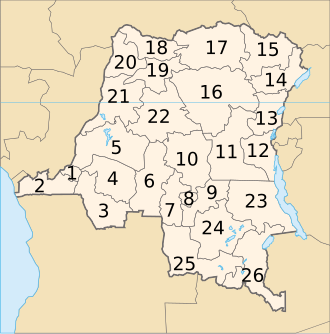History
When Belgium annexed the Belgian Congo as a colony in November 1908, it was initially organised into 22 districts. Ten western districts were administered directly by the main colonial government, while the eastern part of the colony was administered under two vice-governments: eight northeastern districts formed Orientale Province, and four southeastern districts formed Katanga. In 1919, the colony was organised into four provinces:
In 1932, the colony was reorganised into six provinces. Initially they were named after their capital cities, but in 1947 regional names were adopted. [3]
The Belgian Congo became an independent country in 1960, named Republic of the Congo. Under the first constitution, the Loi Fondamentale, six provinces were provided for: Equateur, Kasai, Katanga, Kivu, Leopoldville, and Orientale. The provinces were organized with their own elected assemblies and parliamentary governments responsible to them. Provincial authorities had the power to organise the "political structures of the province within the framework of the general principles contained in the Loi Fondamentale", manage provincial police and judicial officials, establish educational systems lower than higher education, tend to agricultural and mining concessions, construct and maintain local railways, roads, and public works, and manage their own finances, [6] though their funding was heavily subsidized by the central government. Social legislation and national minimum wages were to be concurrent powers shared with central authorities. All other duties and responsibilities rested with the central government. [6] As central authority collapsed due to the outbreak of the Congo Crisis following an army mutiny in July, provincial governments were able to leverage the situation to increase their political autonomy.
The disintegration of central authority led to numerous political discussions aimed at reconciliation and territorial reorganization marked by various political leaders arguing for the creation of new provinces from which many of them sought to personally benefit. In August 1962, 16 additional provinces were promulgated. By 1963, the country was organised into 21 provinces (informally called provincettes) plus the capital city of Léopoldville, similar to the original 22 districts under colonial rule. [3] This framework was confirmed in the Luluabourg Constitution, promulgated in 1964.
Following a coup on 24 November 1965, Colonel Joseph Mobutu became president of the country and the constitution was suspended. Measures were instituted to reduce provincial autonomy and increase political centralisation. On 6 April 1966, a presidential decree reduced the number of provinces to 12. On 24 December, Mobutu declared that the number of provinces would be further reduced to eight. Under the constitution of 27 June 1976, provincial assemblies and ministers were eliminated in favor of appointed governors and advisory bodies. The constitution also left the organisation of provinces to be determined by law.
In 1971, the country was renamed Zaire, and three provinces were also renamed. In 1975, the capital city of Kinshasa obtained the status of a province. In 1988, the province of Kivu was split into three. In 1997, the country was renamed Democratic Republic of the Congo, and the three provinces that had been renamed in 1971 either retook their previous name or took another. [3]
Article 2 of the Constitution of the Democratic Republic of the Congo, adopted in 2006, specifies a territorial organisation into 26 provinces, [17] again resembling the previous provincettes and original colonial districts. The reorganisation was scheduled to take effect within three years of the new constitution's promulgation, however progress was slow. [18] In October 2007 the Minister for Decentralisation, Denis Kalume Numbi, presented a bill for decentralisation in the National Assembly. The subsequent debate turned up a variety of issues that first had to be addressed with changes to related laws. [19] In an October 2010 conclave of the ruling AMP coalition, it was proposed to revise Article 226, which calls for the creation of 26 provinces out of the current 11, in order to allow more time for the transition. [20] On 9 January 2015 the National Assembly passed a law on the new administrative divisions of the country, according to which new provinces should be installed in period of 12 months. [21] [22]
Maps
Districts of the Belgian Congo in 1914
Provinces of the Democratic Republic of the Congo, 1997–2015
Provinces since 2015 (officially formed in 2006)
Approximate correspondence between historical and current provinces





